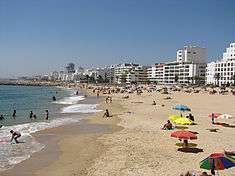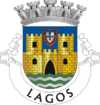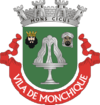Loulé
Loulé (Portuguese pronunciation: [loˈlɛ] (![]()
Loulé | |
|---|---|
_(cropped).jpg) _(cropped).jpg) .jpg) _(318491205)_(cropped).jpg) .jpg) | |
 Flag .png) Coat of arms | |
 Location of the municipality of Loulé in continental Portugal | |
| Coordinates: 37°09′N 8°00′W | |
| Country | |
| Region | Algarve |
| Intermunic. comm. | Algarve |
| District | Faro |
| Established | Settlement: Late Paleolithic Foral: c. 1249 |
| Parishes | 9 |
| Government | |
| • President | Vitor Manuel Gonçalves Aleixo (PS) |
| Area | |
| • Total | 763.67 km2 (294.85 sq mi) |
| Elevation | 49 m (161 ft) |
| Population (2011) | |
| • Total | 70,622 |
| • Density | 92/km2 (240/sq mi) |
| Time zone | UTC±00:00 (WET) |
| • Summer (DST) | UTC+01:00 (WEST) |
| Postal code | 8104-001 |
| Area code | 289 |
| Patron | Nossa Senhora da Piedade |
| Local holiday | Ascension |
| Website | www |
History
.jpg)
Human presence in the territory of Loulé remotes to the Later Paleolithic.[4] The growth of the settlement of Loulé likely stemmed from the late Neolithic, when small bands began rotating agricultural crops and herds around numerous subterranean cavities in its proximity (specifically around Goldra, Esparguina and Matos da Nora).[4] Within the following millennium, the settlements began to grow and intensify with spread of Mediterranean cultures, that progressively penetrated the southwestern part of the peninsula.[4] This culminated in the arrival of the Phoenicians and Carthaginians, who founded the first trading posts along the maritime coast, increasing fishing, prospecting for minerals and commercial activities.[4]
.jpg)
After the 2nd century Punic War, the Roman provided a new impulse to economic activities, expanding the canning industry, agriculture and exploration of copper and iron.[4] In the urban area of Loulé, a sculpted altar to the Goddess Diana, the rustic villages of Clareanes and Apra, and necropolises suggested the extent of Roman occupation.[4] In the 5th century, the Suevians and Vandals, and later the Visigoths, destroyed many of the vestiges of Roman Empire, adapting and assimilating these earlier models of settlement and the cultural experiences of the native populations.[4]
The arrival of Muslim Arabs, in the 8th century, lead to the rise of the historic Al-'Ulya' (Loulé), consisting of a small almedina (fortified city) under the reign of Niebla, under the command of Taifa Ibne Mafom. The second half of the 12th century was an epoch marked by great political and military instability, with internal dissensions across the Garb Andaluz, supported by military constructions.[4] It is possible that Al-'Ulya' was fortified during this period. The remains of the primitive keep remain, practically intact, the Taipa tower (Torre da Vela) situated along the old Rua da Corredora (today the Rua Engº Duarte Pacheco).[4]
The bell tower of Loulé St. Clemens Church (São Clemente) was originally a minaret of a former Muslim mosque. It is one of the few remaining Islamic religious architectural elements from the Arab Moor rule in Portugal. Located across the church is Jardim dos Amuados, which is an old Arab Muslim cemetery.[5]
Kingdom
.jpg)

In 1249, King D. Afonso III supported by D. Paio Peres Correia, Knight and Master of the Order of Santiago, conquered the castle from the Moors, and integrated into the possessions of the Portuguese Crown.[4] The first foral (charter) was issued to the settlement in 1266. A second foral was issued in 1269, to the southern suburbs of Mouraria with narrow winding streets and medieval toponyms, such as Rua da Mouraria and Rua dos Oleiros. The consequences of the Christian Reconquista had a negative effect on the economy of Loulé and its region, which was dependent trade from northern Africa and Andalusia.[4] King D. Denis ordered the establishment of a fair in Loulé, unique to the Algarve, that lasted 15 days in September: it was located in Rossio, in front of the Horta D’El Rei, alongside the Porta de Silves.[4] The new economy, based on agriculture, supported by bartering across regions was insufficient to augment the isolation and stagnation by the end of the 14th century.[4]
The desolate environment in which Loulé was present, were supported by the 1385 Actas de Vereação (Acts of Town Council), by which Camareiro-Mor João Afonso affirmed that the village was unpopulated, its castle in ruins and debris littered the field.[4] In order to alleviate the situation, King D. John I bestowed special privileges on the village to expand the settlement, then donated land in front of the Church of São Clemente for a courtyard. The Actas also gave notice that the King of Castile was prepared to enter Portugal.[4] In order to prevent its eventual attack, there was a move to repair the tower over the Porta de Faro and raise the walls along the southern flank.[4] This area, until the 16th century, for reasons of defense and accessibility was the principal urban space, penetrated by a various roadways: the Largo da Matriz which crossed the principal arterials (the Rua Martim Farto, Rua da Cadeia and Rua da Matriz) which connected the principal spaces of the village, alcaldery, town council, jailhouse and gates.[4]
During Portugal's maritime expansion, the Algarve entered a new economic phase. Loulé, in this context, occupied an important place in the export of wine, olive oil, dried fruit, handicrafts, salt and fish which allowed it to prosper and recover from many years of stagnation and decay: allowing the town to expand public spaces and construct new infrastructures.[4] In 1422, the walls were rebuilt under the orders of D. Henrique de Meneses, first Count of Loulé.[4] In 1471, the old shelter was transformed, by order of King D. Afonso V, into the first hospital in the Algarve, in order to help injured soldiers that regressed from the battles in Tangiers. To the north, and outside the walls, new residential spaces were organized, along the roadways that would become Rua do Poço, Travessa do Outeiro, Rua da Laranjeira and the Rua do Alto de São Domingos (where the Order of Santiago indicated existed the Hermitage of São Domingos in 1565).[4] In the west, they constructed the Hermitage of São Sebastião half a league from the centre, and the Hermitage of Nossa Senhora da Piedade, which complimented the Church of Nossa Senhora dos Pobres (which was erected in 1400).[4]
By the end of the 16th century, Portugal had lost its independence following the events of Alcácer Quibir.[4] The region and village of Loulé was, once again, threatened by coastal attacks from pirates along the coast, yet the castle defenses had already become threatened and had fallen into ruin.[4] After 1630, the economic vitality of the Algarve began to fall, its populations stagnating and political instability contributing to Barbary Coast piracy.[4] The regions expansion suffered, even as new buildings were being constructed: in 1600, the Church of Portas do Ceu was constructed; in the three of the gates of the castle they constructed hermitages to Nossa Senhora da Conceição, Nossa Senhora do Pilar and Nossa Senhora do Carmo; in the courtyard, they constructed the Church of Espírito Santo (then recovered and expanded in 1693); expanded the nunnery of Convent of Nossa Senhora da Conceição; and in the east, D. Francisco Barreto, second bishop of the Algarve, laid the cornerstone of the Convent of Santo António (1675).[4] After the Restoration, the castle took on a defensive role and lands surrounding the structure were occupied by new construction.[4]
By the beginning of the 18th century, during the reign of John V, Portugal lived a period of economica prosperity sustained by gold from Brazil.[4] Many of the churches and chapels were enriched by the spoils of conquest; gold, azulejo, rich woods, and artistic treasures were used to beautify the religious structures of the kingdom, by artesans in the region and factories in the north.[4] A group of public works expanded to the edge of the town, primarily west of the Convent of Graça, south of the old Corredoura, east of the old Largo dos Inocentes square and Rua da Carreira, and north to the Rua da Praça and Rua da Laranjeira.[4] But, much of the village was destroyed in the 1755 earthquake: the towers of the castle cracked, walls crumbled, church and Convent of Graça collapsed, and the patrochial church experienced grave damage; those civilian buildings that were not destroyed became uninhabited and the municipal hall was so damaged that sessions were realized in a small house along Rua Ancha, later in a building on the edge of the municipal square.[4] After the reconstruction of the village new residential areas began to pop-up with several occupied by the local merchant-class.[4]
In the first quarter of the 19th century, the political instability generated by the Napoleonic Wars, the flight of the monarchy and the Liberal Wars provoked an economic crisis.[4] In order to alleviate the financial burden and consolidate the public debit, Ministro da Fazenda (Minister of Finances), Mouzinho da Silveira decreed the sale of national possessions and expropriation of convents.[4] As a consequence, the Convent of Espírito Santo, closed since 1836, was occupied and transformed into the municipal hall and judicial tribunal, while the church converted into a theatre.[4] Meanwhile, alongside the walls of the old castle, the lots were occupied for residential and commercial purposes. However, the greatest transformation occurred with the opening of Avenida Marçal Pacheco that connected the east and west, along the Rua da Praça (today Avenida Praça da República), resulting in the demolition the hermitage of Carmo and part of the wall alongside.[4] The Rua da Praça was along the principal circulation of the most important social, economic and cultural space in the tow.[4] In 1885, it began to symbolize the most important political space in the town, after the municipal council was transferred to its current place.[4] At the end of the 19th century, the town had expanded to the west, initiating a new phase of urbanization in Quinta do Olival de São Francisco, which was integrated into the new civil parish of São Sebastião, created in 1890 after São Clemente was divided.[4] This new zone had a modern plan with roads design from existing roadways, forming rectangular blocks and triangular public spaces.[4] The urban and demographic growth in this period was associated with industrialization that attracted a nascent population to small artisanal factories.[4] This process was aided by the evolution of transport, the construction of rail lines in the Algarve and the development of communication lines that contributed to the demographic shift of the municipality.[4]
Before the establishment of the First Republic, many of the contemporary architectural structures were constructed, including the municipal market, a project of architect Mota Gomes.[4] This project substantially altered the urban character of the town, provoking the considerable destruction of the castle. But, it was the opening of the Avenida José da Costa Mealha that had a considerable logistic and architectural impact on the town.[4] Until the establishment of the Estado Novo, the greatest improvements came from replacing the public lighting and installation of a water supply and drainage system.[4] Following the military coup on 28 May 1926, until the Carnation Revolution, the growth of Loulé proceed moderately with the modernization of Avenida José da Costa Mealha (today Avenida 25 de Abril), that helped to spur many of the more expressive buildings in the town (such as the Cine-Teatro Louletano and the Duarte Pacheco monument). These developments assisted in accelerating the construction in Loulé.[4] To the northeast and south of Avenida José da Costa Mealha large residential blocks occupied old agricultural properties and traditional architecture.[4]
Geography

.jpg)
Loulé is well known for the sandy beaches, such as Quarteira. Inland, Loulé shows a rich geology, paleontology,[6] and wildlife.
Administratively, the municipality is divided into 9 civil parishes (freguesias):[7]
- Almancil
- Alte
- Ameixial
- Boliqueime
- Quarteira
- Querença, Tôr e Benafim
- Salir
- São Clemente
- São Sebastião
Economy

A highlight of the summer months in Loulé is Noite Branca, the Festival of White Night held to celebrate the end of summer. Locals and tourists, all wearing white, converge on the town, where a dazzling display of music, dance and pageantry awaits. Young people wander the streets, dressed in white as princes and princesses, demons and winged fantasy figures, while live bands play in the background.[8]
Loulé is also the largest municipality in the Algarve and includes well-known towns near the sea (like Vilamoura or Quinta do Lago) but also the hidden villages in the Algarve mountains where there are unmistakable landscapes.
Sport
In Pavilhão Desportivo Municipal de Loulé, a World Cup is held every year in the sport of trampolining.[9]
Notable citizens
- António Carrilho (11 April 1942 -), is a Roman Catholic priest and bishop of Funchal
References
- Detail Regional Map, Algarve: Southern Portugal, ISBN 3-8297-6235-6
- Instituto Nacional de Estatística
- "Áreas das freguesias, concelhos, distritos e país". Archived from the original on 2018-11-05. Retrieved 2018-11-05.
- "História" (in Portuguese). Loulé, Portugal: Município de Loulé. 2018.
- "LOULÉ". algarvetips.com. Retrieved 1 October 2018.
- Brusatte, S. L., Butler R. J., Mateus O., & Steyer S. J. (2015). A new species of Metoposaurus from the Late Triassic of Portugal and comments on the systematics and biogeography of metoposaurid temnospondyls. Journal of Vertebrate Paleontology, e912988., 2015
- Diário da República. "Law nr. 11-A/2013, page 552 61" (pdf) (in Portuguese). Retrieved 24 July 2014.
- My weekly, Festival Nights in Portugal, Nov 5-11 2013
- "Website of the city council about the Loulé World Cup Trampoline". Retrieved 2014-11-02.
External links
| Wikivoyage has a travel guide for Loulé. |
| Wikimedia Commons has media related to Loulé. |
| Municipality of Faro District (Algarve) |
|
|---|
.png) Albufeira |
 Alcoutim |
.png) Aljezur |
.png) Castro Marim |
 Faro |
.png) Lagoa |
 Lagos |
.png) Loulé |
 Monchique |
 Olhão |
.png) Portimão |
.png) São Brás de Alportel |
.png) Silves (Portugal) |
.png) Tavira |
.png) Vila do Bispo |
.png) Vila Real de Santo António |
| Albufeira | Alcoutim | Aljezur | Castro Marim | Faro | Lagoa | Lagos | Loulé | Monchique | Olhão | Portimão | São Brás de Alportel | Silves | Tavira | Vila do Bispo | Vila Real de Santo António |